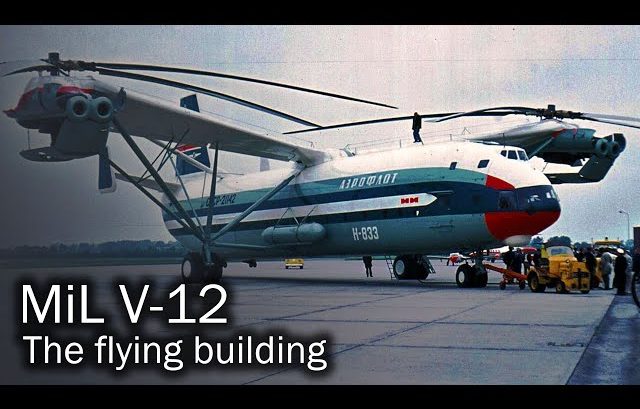The Mil V-12 is a heavy transport helicopter built in the USSR during the late 1960s. It was the biggest helicopter in the world and was created to carry Russian missiles to remote forest locations, away from the US’ eyes.
Primary Purpose
While the V-12 may look like an experimental aircraft, it has a primary purpose and that is to carry Soviet nuclear missiles. While the Soviets had big helicopters, they wanted something large enough to carry the missiles into new locations.
This is because spy planes from the US can find their location, as well as railway tracks connected to every launch site. Thus, the need to lift missiles to locations, made it virtually impossible for American spy planes to figure out their new locations.
The V-12
This eventually led to the birth of the V-12, a helicopter that looked like a cross between a conventional aircraft and a helicopter. It truly had a stunning design.
The V-12 is a very large helicopter. It’s 37 meters long, 34.4 meters wide, and not including the span of rotors, 35 meters in diameter each, and 12.5 meters high. Overall, the thing is a size of a Boeing 737. It also has a maximum take-off weight of 105 tons.
The plane could carry most types of civilian and military equipment including parts of ballistic missiles. The helicopter was also superior to most full-fledged military transport aircraft.
Trials and Development
Flight tests began in 1967, and on July 27, the machine took off for the first time at the airfield in Panki near Moscow.
The first flight was unsuccessful- the plane rose to a low altitude but began swaying in the air, making a hard landing. The first full-fledged and official flight of the V-12 was made on July 10, 1968, and then everything went well.
As part of the testing program, a lot of nuances were revealed and many systems were enhanced, but overall the helicopter didn’t change anymore and behaved quite tolerably, was well-controlled, and wasn’t even particularly noisy.
Records and Airshows
The plane was able to break records lifting 31,030 kg of cargo to a height of 22,951 meters as well as lifting 44,205 kg to a height of 2,255 meters- a feat that was conquered many years later.
The V-12 also flew in the Paris Air Show. The helicopter was so huge that there was simply nothing to compare it in the industry. The giant got the Sikorsky Award from the American Vertical Flight Society for its outstanding achievements in helicopter technology.
By 1973, the second prototype was ready for testing, making its maiden flight. It seemed like its serial production won’t be so far away.
Aborted Takeoff
The military not only saw outstanding performance but also potential issues in mass operations. The V-12 was a very complex machine, and its carrying capacity seemed redundant, not justifying itself.
Airplanes were handling transport tasks relatively well, and the concept of rapid deployment of ballistic missiles by planes and helicopters had lost its relevance. Now, the military needed a modest, simpler, and cheaper machine to operate. In 1974, the V-1 tests were canceled and the entire program followed.



